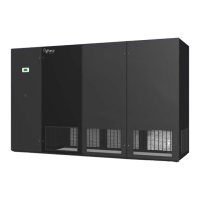18
Do not expose drain line to freezing temperatures. Drain line may contain boiling water therefore use
copper or other suitable material. Drain line must comply with local building codes. It is recommended
to install under-oor leak detection equipment whenever possible.
Note: Condensation formation and frequent humidier ushing are normal functions
of this equipment. Proper drain connections must be made to ensure proper removal.
Unit will require water connections for condensate removal and possibly for humidier
makeup water, condenser water, water/glycol and/or hot water. Installation of units above
equipment that could sustain water damage should be avoided.
WARNING: The condensate drain MUST be connected to an external drain line (provided
by others) before unit start up.
2.9 Humidier Piping
2.9.1 Steam Generator Humidier
The standard humidier in the systems is a steam generator humidier type with disposable cylinder.
The humidier makeup water should be brought to the humidier through the eld connection opening
using 1/4” (6.4 mm) copper tubing. A compression tting is provided at the humidier.
A shuto valve should be provided outside the air conditioner to allow disconnection for service. An in-
line water pressure regulator and strainer should be installed. Water pressure should be set between
20 and 80 PSI (128 and 552 kPa).
The humidier has a drain at the bottom which is factory piped to the main condensate drain line. The
dispersion tube also has a drain line. No additional eld piping is required.
Note: Do not supply steam generating humidier with softened water. Also, do not use
hot water source.
2.9.2 Dry Steam Humidier
2.0.1 The optional dry steam humidier requires a strainer on the inlet steam line. An outlet connection
with eld-provided steam trap is also required. Steam pressure is typical 10 to 15 PSI (69 to 103 kPa).
2.10 Leak Testing
WARNING: No installation is complete until the entire system has been thoroughly
checked for leaks. This includes checking the refrigerant tubing, are ttings, pressure
controls, Schrader ttings and compressor roto-lock service valves. Check both the
eld and factory connections,
In addition to refrigeration system, check all condenser water lines, humidier water makeup lines,
condensate lines, condensate pumps, chilled water lines, centrifugal pumps and uid cooler (where
applicable).

